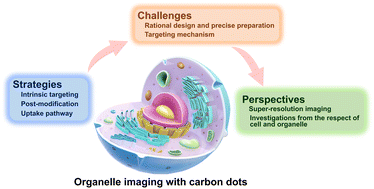Organelle imaging with carbon dots: strategies, challenges, and perspectives
Abstract
Organelle imaging is an efficient approach to gain information about intracellular events and dynamics of subcellular structures. In this case, carbon dots (CDs) are outstanding fluorescent probes for organelle imaging due to their excellent biocompatibility, tunable and stable fluorescence, anti-photobleaching, and easy and cheap preparation. In the past decade, numerous investigations have made great progress in regulating the physicochemical properties of CDs for targeted organelle imaging. However, there are several obstacles that hinder the further understanding of subcellular events, such as the unsatisfactory organelle specificity of CDs and their inconsistent organelle-targeting mechanism. In addition, researchers have focused on how to produce organelle-targeting CDs but ignored the fact that cells and organelles also affect the subcellular distribution of CDs. Thus, in this review, we outline the development in the field of organelle-targeting imaging using CDs as probes, summarize the general strategies for targeted imaging using CDs, discuss the challenges in this field, and propose potential solutions. We hope that this review will facilitate the further development of organelle imaging using CDs as probes.

- This article is part of the themed collection: 2023 Inorganic Chemistry Frontiers Review-type Articles


 Please wait while we load your content...
Please wait while we load your content...